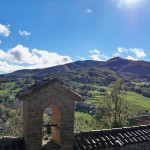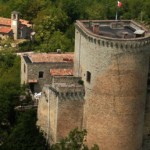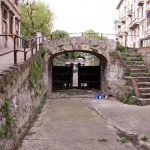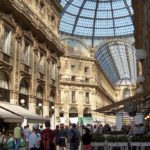At the centre of the 4 provinces: Pavia, Alessandria, Piacenza and Genoa
The Sforza Castle of Milan
Home of museums, libraries, archives and tourism
Reach the Sforza Castle of Milan by bike, cycling along the path close to the canal. Then visit this grandiose centuries-old castle which has changed its nature several times according to the historical periods and dominations.
Nowadays it is the home of museums, libraries, archives and tourism as well. Most importantly there’s the Sala delle Asse, a wonderful place conceived by Leonardo Da Vinci, that was brought back to light as a result of some restoration work.
⇒ Watch the full web serie Milan & Leonardo da Vinci
Visit Sforza Castle official website
Visit Turismo Milano official website
Visit Hotel Concorde Milano website
Video full text: Sforza Castle
This is the famous and traffic-congested Viale Monza.
I don’t have my bike any more, but the hotel should have some!
I’ll go and ask, they may even lend me one.
Whose are those bikes?
They’re ours, for our guests’ use.
OK. Can I take one then?
Of course, and we can also give you a map showing all of the city’s cycle paths.
I’ll show you, it’s easy.
We’re here, at the Hotel Concorde.
If you take Via della Martesana, the name of Milan’s historic canal, you’ll be heading for the centre of the city.
I’ll take it! Can you open it up for me?
Did you start doing this before the local council began its own bike sharing scheme?
Yes, several years ago.
There’s the old Martesana mill over there, and this is the canal.
A Milan that is totally unthinkable.
Will I get through?
And to think that this canal arrives here from Trezzano d’Adda,
it really is a laudable piece of work.
This segregated cycle path, that’s close to the canal, is in a place that looks like a totally different Milan,
that of the 19th century, from another age, perhaps even that of Leonardo da Vinci, well almost,
and it leads to the castle.
It’s quite a few kilometres, using this cycle path, that can also be covered by running, if one has the energy.
I have the energy to cycle there!
So here I am at the grandiose Sforza Castle, where Claudio is waiting for me.
Welcome to Sforza Castle.
Is it possible to sum up the history of this centuries-old castle in a second?
We’ll try.
Its origins date back to the Visconti family, in the second half of the 14th century.
We are in one of the oldest areas, the Pusterla, within the boundary of Azzone.
This corresponds to the era of the House of Visconti,
who reinforced one of the city’s oldest gateways.
Its true glory came with Francesco Sforza, who made it the headquarters of the city’s rulers.
His successors, Galeazzo Maria and Ludwig the Moor, transformed it into one of the most famous courts of the renaissance period.
Decay then ensued, and with the Spanish period the castle became a fortress.
That was until the arrival of Napoleon, who knocked down the outer walls,
in order to lessen the architectural and the military impact as well.
Yes, it must have been frightening!
Then, during the unitary period, and the Austrian period before that, it returned to being a barracks.
From the towers the Austrians would shoot at people during the Five Days of Milan.
They would cannonade the insurgents and patriots.
The Milanese were holed up in here.
Once the Austrians had been ousted it was viewed as a symbol of tyranny.
With Italy’s unification the castle once again became a barracks and the Milanese wanted to destroy it.
But the architect and historian Luca Beltrami along with the Committee of the Milanese, managed to save it,
and they turned it into a centre for culture, which is what it is today.
It is the home of museums, libraries, archives and tourism as well.
There are so many visitors in this huge area.
Huge, as most things are in Milan! From the Duomo to the Castle.
Most importantly there’s the Sala delle Asse, a wonderful place,
that was brought back to light as a result of some restoration work.
Beneath 18 layers of plaster we found drawings by the maestro Leonardo.
Leonardo had conceived it with the mind of a modern designer,
somebody else finished it.
He didn’t have the time, he had too many commitments!
Let’s go and have a look at the Sala delle Asse.
It’s undergoing restoration work that will take another few years.
In addition to the preservation work, there’s also the research site,
where we try to get some idea of what lies beneath these replasterings.
We’re going to climb up onto the scaffolding that leads to where they’re working
to clean these images that are undoubtedly attributable to Leonardo.
This is a preparatory drawing,
or even a trompe l’oeil, a monochrome that’s done and finished.
It’s a trunk, a root that entangles itself into a mass of stones.
The base was drawn in charcoal, the shadows were painted with a brush.
These plants are the result of a naturalistic study,
it’s all an intertwining, with the bows there on top.
His intention was undoubtedly to astound, this was an elegant room for receptions,
reserved for the court. Les Jardins de Milano
He must really have researched this intertwining very closely,
perhaps by thinking about the vineyard that was given to him as a present by Ludwig.
He looked closely at the intertwining of the vegetation.
These columns are trees with roots that entangle themselves into the brickwork.
Something that’s both archaic and ancient.
A sort of canopy, held up by sixteen black mulberry trees.
So-called morone (large moor), thus evoking the name of Ludwig the Moor!
The Milanese were very grateful to Ludwig, known as the Moor,
because it was he who introduced the mulberry tree for the breeding of silkworms.
Silk was a key part of Lombardy’s economy.
Or perhaps it was Ludwig himself who asked Leonardo to create this room.
He got him to think about it and design it, in part so as to use the characteristics of the black mulberry to represent him, the Moor.
What problems did you encounter in the restoration of this room?
There are all the different layers of a variety of plasters, that had to be scraped away using scalpels.
There’s the actual numbering: 5… 4… 3… 2… 1.
And here’s Leonardo’s preparatory drawing!
It would seem that these parts were never ever coloured.
Perhaps because of the arrival of the French, or perhaps because he was distracted, as always.
There’s also a socio-political aspect:
Ludwig the Moor was forced to flee with all of his court, including Leonardo.
This is Leonardo’s ghost! Look!
It was probably summoned up by a restorer at some point.
The problem of the restoration is very important.
We Italians lead the way in this sector and we don’t exactly make it simple:
it’s important to have an understanding of the material he used and to proceed, one centimetre at a time.
The amount of work we do every day depends on the portion,
but sometimes, in an entire day, we only do a few centimetres.
We invite you to come back very soon!
Also because we’re really the first.
All of this is made possible thanks to financial backers,
who fund this really slow but truly important work.
Today, as it was then, art has to be aided, funded, supported.
That was Leonardo’s way of thinking as well.
It needs money.
I mean, what did those Japanese see of this room if they didn’t see what we saw?
Naturally there is also a video presentation that will tell us.
“The room we are in now, known as delle Asse (of the wooden boards),
was created on the instructions of the Duke of Milan, Ludwig the Moor”
And you’ll be able to hear everything I have just told you, thanks to the voice of a hologram.
“This was the decoration of the vault, just as we see it today”.
Visit Milan: helpful hints
Italian name: Milano
Arrival
Milan has got three airports:
- Malpensa Airport is the largest international & intecontinental Airport in Northern Italy. 30 miles Northwest from the city centre. Connections:
→ Train Malpensa Express: trains leaves every 30 minutes in each direction, connecting the Airport to Milan Grand Central Station or Cadorna Railway Station. Terminals 1 and 2. It takes 45 min, price: 14 €
→ Shuttle Bus: Malpensa Shuttle and Malpensa Bus Express connect the airport to Milan Grand Central Railway Station and Milan’s Underground Network. Terminals 1 and 2. It takes 60/70 min, price: 8 € - City Airport Linate is an international airport connecting Milan with main European cities, located just 4 miles from the city centre. Connections by shuttle: Atm Bus n. 73 from Milano Duomo M1 – M3 (Piazza Diaz, direction: San Babila), first ride at 5.35 am, last one at 00.35. Frequency: every 10 min, price 1,5 €
- Milan Bergamo Airport Orio al Serio is mainly low cost flights Airport, located 30 miles Northwest from Milan. Connections only by Shuttle: There are 4 different bus companies, pricing changes from 5 up to 8 €
Transports
ATM is Milan public transport service both for bus, tram and subway. Single ticket costs 1.50€ for 90-min ride. Consider daily/weekly subscriptions. You can buy tickets also texting to 48444. Milan Subway is the longest in Italy, covering 95 km: Donwload and check the map.
Moving in town can be nice also by bike: Milan has got a powerfull bike sharing service providing both regular and e-bikes. Here is the experience of our Ambassador Kim Harding with BikeMi service and a useful video of our Ambassador Roxana explaining how does it work. Car Sharing is also good with many different companies to choose.
Try also the local urban railway train, called Passante Ferroviario, check the experience of our Ambassador Roxana Iacoban travelling by local train in town.
What to do in Milan
Milan is the Italian financial center and one of the European capitals of Fashion. Known for its nightlife as well.
Some tips on Italia Slow Tour: watch our web serie about Leonardo da Vinci’s places, climb on top of the Duomo, visit Prada Foundation, Museums and Art Galleries, taste some fine gelato and try the local Aperitivo and – not joking – enjoy a sailing trip (!!) or some time deep in the nature close to some actual farms and fields.
Where to sleep
Accomodations are quite expensive in Milan, fares rise up and hotels get full according to the rich event calendar of the city (see: Fashion Week, Salone del mobile, Big concerts, Theatre and Sport events, etc.). If you are not specifically interested in any of those, try to travel during other periods to save some money.
Italia Slow Tour recommends:
- Hotel Cervo in Garibaldi District if you want to stay close to city centre and enjoy the nightlife
- Hotel Concorde located on the Green Way Milan-Lecco to Lake Como, if you want to move around adn travel by bike
Shopping in Milan
The famous Fashion District involves the following streets/areas: Via Montenapoleone, via Manzoni, via della Spiga and Corso Venezia. The so called “Quadrilateral of Fashion”. Here you can find all kind of brands and shops. Easy to reach by Subway (stop at Montenapoleone station).
Don’t miss the Street Markets! Almost every day you can find one: best are the ones in Viale Papiniano (on Tuesday) and Via Fauchè (on Saturday). More on the official website of weekly street markets. If you are into sustainable local products, Milan has got 8 actual farms in town and a green Earth Market.
If you are interested in Outlet Shopping, in the outskirt of Milan you can find 4 different Fashion Outlets, in a radius of 62 miles. Here you can find everyday a lot of famous high quality Italian brands on sale, with prices cut off up to 50%. All the outlets are connected to the center of Milan by Shuttle Bus:
- Serravalle Designer Outlet – Shuttle departure from Milan Central Station or Cairoli square
- Fidenza Village Outlet Shopping – Shuttle departure from Piazza della Repubblica 5, at the corner with Turati st.
- Vicolungo The Style Outlets – Shuttle departure from Cairoli square
- Rodengo-Saiano Franciacorta Outlet Village – Shuttle departure from Cairoli square















1 Comment
Il mio Slow Tour a Milano | Nomadizziamoci
[…] Il Castello Sforzesco e la Sala delle Asse […]